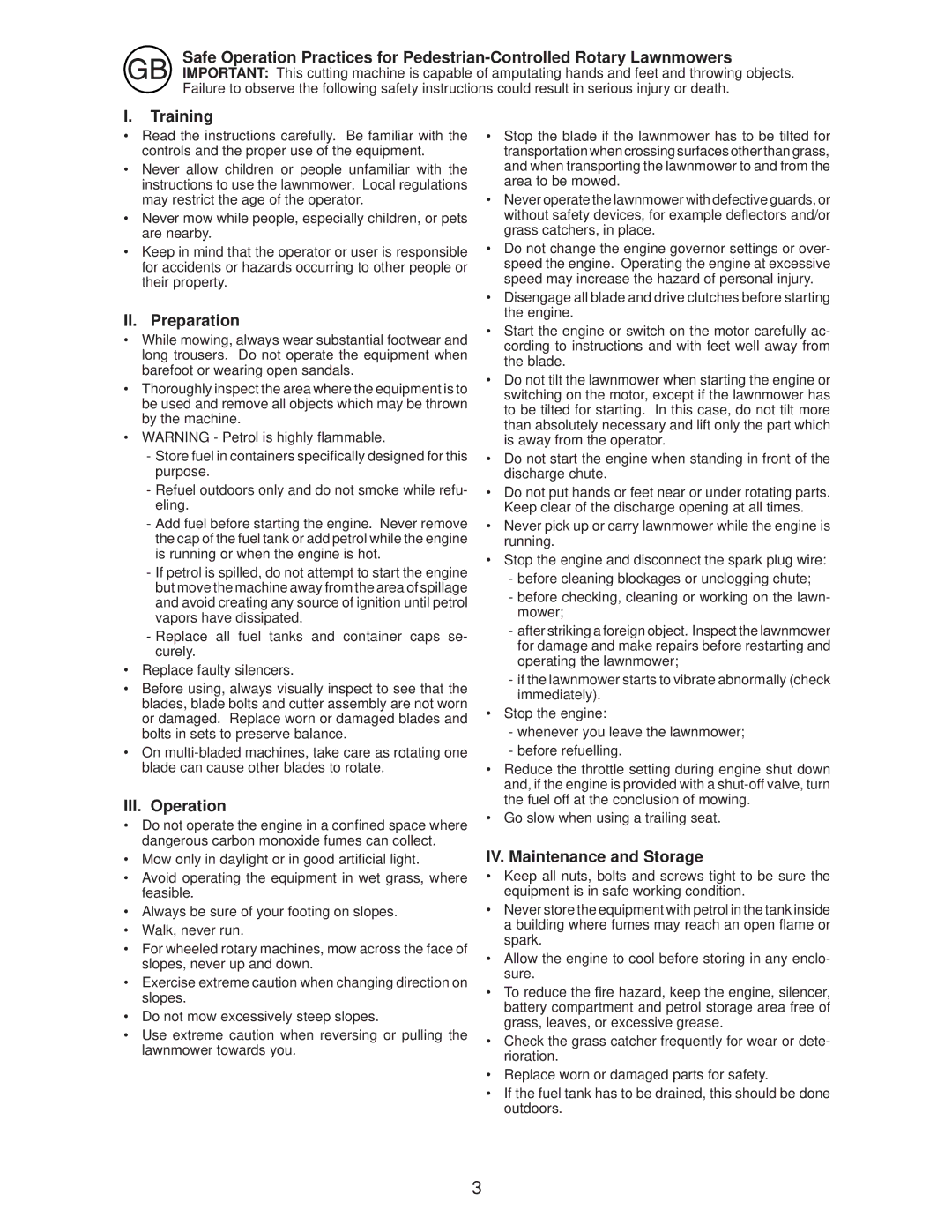Safe Operation Practices for
IMPORTANT: This cutting machine is capable of amputating hands and feet and throwing objects. Failure to observe the following safety instructions could result in serious injury or death.
I.Training
•Read the instructions carefully. Be familiar with the controls and the proper use of the equipment.
•Never allow children or people unfamiliar with the instructions to use the lawnmower. Local regulations may restrict the age of the operator.
•Never mow while people, especially children, or pets are nearby.
•Keep in mind that the operator or user is responsible for accidents or hazards occurring to other people or their property.
II. Preparation
•While mowing, always wear substantial footwear and long trousers. Do not operate the equipment when barefoot or wearing open sandals.
•Thoroughly inspect the area where the equipment is to be used and remove all objects which may be thrown by the machine.
•WARNING - Petrol is highly fl ammable.
-Store fuel in containers specifi cally designed for this purpose.
-Refuel outdoors only and do not smoke while refu- eling.
-Add fuel before starting the engine. Never remove the cap of the fuel tank or add petrol while the engine is running or when the engine is hot.
-If petrol is spilled, do not attempt to start the engine but move the machine away from the area of spillage and avoid creating any source of ignition until petrol vapors have dissipated.
-Replace all fuel tanks and container caps se- curely.
•Replace faulty silencers.
•Before using, always visually inspect to see that the blades, blade bolts and cutter assembly are not worn or damaged. Replace worn or damaged blades and bolts in sets to preserve balance.
•On
III. Operation
•Do not operate the engine in a confi ned space where dangerous carbon monoxide fumes can collect.
•Mow only in daylight or in good artifi cial light.
•Avoid operating the equipment in wet grass, where feasible.
•Always be sure of your footing on slopes.
•Walk, never run.
•For wheeled rotary machines, mow across the face of slopes, never up and down.
•Exercise extreme caution when changing direction on slopes.
•Do not mow excessively steep slopes.
•Use extreme caution when reversing or pulling the lawnmower towards you.
•Stop the blade if the lawnmower has to be tilted for transportation when crossing surfaces other than grass, and when transporting the lawnmower to and from the area to be mowed.
•Never operate the lawnmower with defective guards, or without safety devices, for example defl ectors and/or grass catchers, in place.
•Do not change the engine governor settings or over- speed the engine. Operating the engine at excessive speed may increase the hazard of personal injury.
•Disengage all blade and drive clutches before starting the engine.
•Start the engine or switch on the motor carefully ac- cording to instructions and with feet well away from the blade.
•Do not tilt the lawnmower when starting the engine or switching on the motor, except if the lawnmower has to be tilted for starting. In this case, do not tilt more than absolutely necessary and lift only the part which is away from the operator.
•Do not start the engine when standing in front of the discharge chute.
•Do not put hands or feet near or under rotating parts. Keep clear of the discharge opening at all times.
•Never pick up or carry lawnmower while the engine is running.
•Stop the engine and disconnect the spark plug wire:
-before cleaning blockages or unclogging chute;
-before checking, cleaning or working on the lawn- mower;
-after striking a foreign object. Inspect the lawnmower for damage and make repairs before restarting and operating the lawnmower;
-if the lawnmower starts to vibrate abnormally (check immediately).
•Stop the engine:
-whenever you leave the lawnmower;
-before refuelling.
•Reduce the throttle setting during engine shut down and, if the engine is provided with a
•Go slow when using a trailing seat.
IV. Maintenance and Storage
•Keep all nuts, bolts and screws tight to be sure the equipment is in safe working condition.
•Never store the equipment with petrol in the tank inside a building where fumes may reach an open fl ame or spark.
•Allow the engine to cool before storing in any enclo- sure.
•To reduce the fi re hazard, keep the engine, silencer, battery compartment and petrol storage area free of grass, leaves, or excessive grease.
•Check the grass catcher frequently for wear or dete- rioration.
•Replace worn or damaged parts for safety.
•If the fuel tank has to be drained, this should be done outdoors.
3
